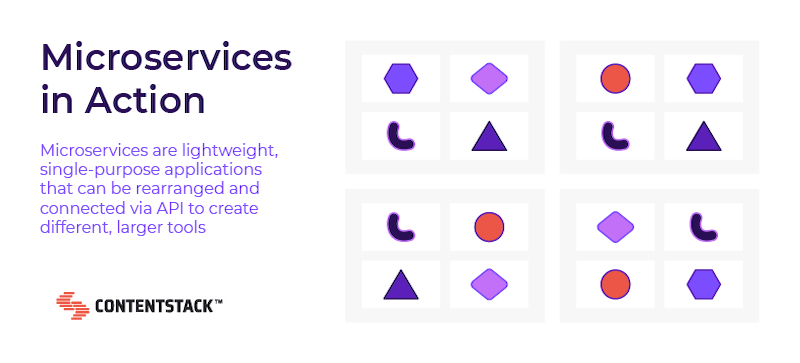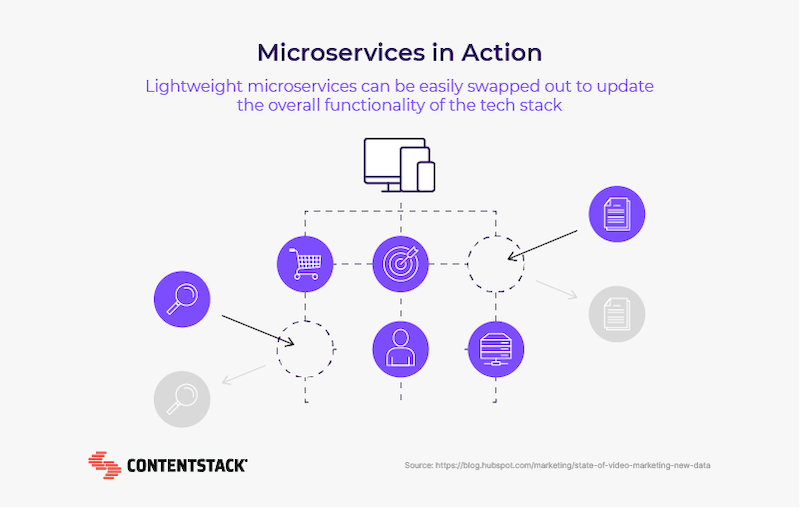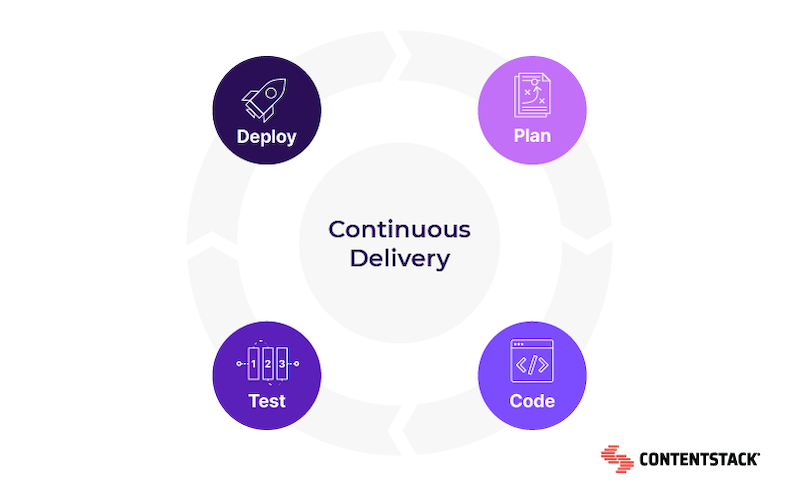Reimagine your business operations with microservices
Read this guide to understand the power of microservices architecture for your business. To learn how to seamlessly migrate from monolithic systems and transform your operations into a microservices architecture, schedule a demo today.
Highlights
You’ll learn:
- Understand microservices' benefits and challenges.
- Learn about the role of an application programming interface or API gateway in managing service composition and authentication.
- Discover how service discovery enhances network communication.
- Explore the benefits of CI/CD pipelines for rapid, reliable feature delivery.
- Check recommended microservices architectures for a headless CMS and how to choose an architecture.
- The strategic process of migrating from monolithic to microservices architecture.
Keep reading to explore more!
Microservices have become popular in the last few years as companies adopt DevOps and continuous testing processes to become more agile. With companies such as Amazon, PayPal, and Netflix moving to microservices from monolithic architecture, the future of these services is bright.
In this article, we understand what microservices are, explore their benefits and challenges, and focus on understanding and implementing microservices in software development.
What are microservices?
Microservices or microservices architecture is a cloud-native approach to developing software and applications. It's a set of small independent service units communicating through a well-defined API. Each service runs in its process and solves a complex business problem.

Microservices are small, modular, and flexible units of software. They work with other services to solve complex business problems and deliver applications. You can split these services into different functional applications. It lets you add, rearrange, and remove them anytime to create custom applications.
Think of your last visit to Netflix. You used their search bar to browse movies and shows. That search represents one service.
You also saw movie recommendations based on your history or location. That’s another service offered by Netflix.
Adding these together, you get a functional application. This division by Netflix makes their system more robust and resilient. Also, the failure of one service has zero impact on the complete application.
These services innovate and improve independent application areas without changing the system. Development and operations teams collaborate for a smooth process. With microservices, application development follows a business-centric approach, helping you meet changing requirements.
Monolithic vs. microservices architecture
Microservices offer more benefits than monolithic architecture, as shown in the table.
|
Feature |
Monolithic architecture |
Microservice architecture |
|
Structure |
Single unit with connected and dependent components. |
Collection of independent units, each responsible for specific business functionality. |
|
Deployment |
Versioning and redeployment of the entire application, even for small updates, are necessary. |
Deploy individual services separately without affecting others. |
|
Scalability |
Scaling requires copying the entire application, which may be resource-intensive. |
Scales autonomously, allowing for efficient resource use. |
|
Flexibility |
Changes affect the whole system, reducing flexibility. |
Update or replace services without impacting the rest of the application. |
|
Development |
Large code base reduces the speed of development cycles and new feature integration. |
Enables parallel development workflows, rapid iteration, and feature rollout. |
|
Complexity |
Initially simple but can grow in complexity as the application scales. |
Manages complexity with well-defined interfaces and services. |
|
Development teams |
Teams often work on the same codebase, which can create bottlenecks. |
Teams can work on different services together, increasing team autonomy. |
Microservices use a modular approach to software development, where changes to one functionality do not impact the entire application or other functionalities. After understanding the differences, making strategic decisions about the design of our software infrastructure becomes easy.
Overcome traditional CMS issues with Contentstack: Are you tired of slow development times and rising costs due to legacy monolithic suites? Contentstack offers a modern, component-based solution designed for the needs of today's enterprises. Discover agility and improved ROI. Request a demo to learn more.
Benefits of microservice architecture in cloud environments
Besides helping your business deliver custom applications and tools, the benefits of microservices in cloud computing are:
Makes your applications and system scalable
With these services, you deploy and scale individual services. When done right, these services need less infrastructure than monolithic applications. This is because it allows precise scaling of the components you need. You no longer have to scale all your components.
For instance, online retailers can increase their servers' capacity during peak season. This helps them process checkout transactions without affecting other parts of their website.
Increases flexibility
Microservices help your development team choose technology stacks depending on their business needs. It helps you choose the latest technologies and programming languages. For instance, you can use Python for analyzing data or React for front-end development. As a result, you adopt technologies like AI and IoT, helping you outsmart the competition.
Independently deployable
Because of the small size of independent components, deploying microservices is a breeze. Developers don’t have to overhaul the entire system coding to add new features or change a single line of code.
You no longer wait for hours together to deploy a simple code change. As a result, speed and agility become your software’s unique selling proposition. You can update and enhance independent components based on the changing environment.
Improves deployment time
In a monolithic architecture, developers had to wait to deploy a large application. But microservices allow for swift and targeted updates and rollbacks. Different teams work together to update services, reducing the development and deployment time.
Cross-functional teams ensure their applications evolve in real time with the least disruption. This agility is critical for companies offering speed and reliability in their applications.
Empowers your development team
Microservices architecture cultivates a culture where development teams thrive on independence. They own services throughout the entire lifecycle, from design to deployment. A streamlined workflow reduces inter-team dependencies and fosters innovation.
Simplifies debugging and maintenance
Developers resolve issues by isolating and addressing them within individual services, simplifying debugging.
Because the services are small and less interconnected, it's easy to maintain them.
Contentstack: A Leader in CMS Performance. Experience the strength of Contentstack, a standout performer in Forrester's Q3 2023 CMS report. Contentstack simplifies your digital experience with our back-end extensibility and global deployments. Request a demo to learn more.
Challenges of a microservices architecture
With benefits come significant challenges, like
Complexity in system design
When you shift to microservices, your design and deployment complexity increases. This is because you handle many components. Each service functions within its domain. As a result, you adopt different strategies for meeting communication protocols.
Slows down your performance
A container increases computing performance. But it communicates with different networks for your application to function. Network latency can reduce the performance of your microservices applications. When using a modular architecture, ensure efficient and reliable communication between services.
Difficult data management process
Unlike monolithic architectures, where you need a single database, microservices need multiple databases. This increases the complexity of managing data consistency, database migrations, and distributed transactions.
Building blocks of microservices
Containers
Containers are lightweight and standalone packages. They contain the code, runtime, system tools, libraries, and settings. These containers:
- Isolate different services,
- Resolve software dependencies and
- Ensure consistent development, staging, and production environments.

API gateway
An API gateway is the clients' entry point. APIs send requests to these modular services. It simplifies the client-side experience by:
- Allowing different services within a microservice to share information and functions as one.
- Managing service composition
- Aggregating outcomes from various services
- Offering a centralized hub for cross-cutting issues like authentication.
Service discovery
As microservices scale within the infrastructure, service discovery detects services in the network. This results in communication and functional collaboration among different services.
Load balancer
Microservices use load balancers to distribute incoming network traffic across many back-end services. Load balancers increase your application's responsiveness and availability. They ensure no single microservice works like a performance bottleneck.
Continuous Integration / Continuous Deployment (CI/CD)
CI/CD pipelines provide rapid, reliable delivery of new features, fixes, and updates. CI/CD encompasses the following essential practices to implement microservices:
- Automated testing: With many services operating, automated testing is necessary. Automated testing ensures your new code commits don't break your existing functionalities.
- Continuous integration: CI merges code changes into a central database. This resolves conflicts, reduces integration time, and improves software quality.
- Continuous deployment (CD): CD guarantees that code modifications undergo automated testing. It even ensures automatic implementation in the production environment. CD minimizes human errors and decreases the time taken for deployment.

6 Best platforms for microservices
Microservices architecture makes your system scalable and flexible. With microservices, your team works together on different services. These are the best headless content management systems (CMS) that power a flexible microservice architectures.
Contentstack
Contentstack is a microservice platform that helps companies with content management. As a headless CMS, it integrates with various services, providing a microservices-driven approach. This helps companies manage their content across various channels and platforms. Equipped with agile functionalities, Contentstack streamlines content workflows and enhances user experiences.
How Contentstack helped Emma launch omnichannel campaigns 8x faster
Emma, a leading sleep brand, overcame legacy issues using microservices and composable architecture with Contentstack. This shift enabled faster campaign launches, improved collaboration, and flexibility in content creation. Emma brought a landmark change in store-building processes and expanded the use of Contentstack for nonstore websites and mobile apps.
After using Contentstack, Andreas Westendörpf, Chief Technology Officer at Emma, said:
“The Contentstack user interface has really improved the developer work environment and we are beginning to see the creative teams develop wider experiences that should increase conversion.”
Read the full case study here.
Contentful
Contentful is a headless CMS known for its microservice architecture. It offers robust APIs, allowing developers to distribute content across various channels.
Storyblok
Storyblok is another headless CMS using a component-based approach. As a result, it’s compatible with a microservice architecture. It makes your CMS flexible and scalable.
Sitecore
Sitecore is a digital experience platform (DXP). It supports microservices through its Experience Platform and Experience Commerce solutions. Its versatile tools solve diverse business needs within a framework.
Kontent.ai
Kontent.ai is another headless CMS designed to centralize content management and distribution. Its API-first strategy aligns with microservices architectures, ensuring content deployment across multiple channels.
Adobe Experience Manager (AEM)
AEM is a platform supporting microservices architectures. AEM as a cloud service makes your systems adaptable and scalable. It helps you deliver superior digital experiences.
How to choose a microservice architecture
Selecting the right architecture helps your business grow in the long run. When evaluating options, focus on these features:
- Scalability: Choose tools that help you scale up or down depending on your load and market demand. Cloud auto-scaling is a feature to look for.
- Performance: Ensure your architecture provides low-latency communication between services. Many companies prefer architectures that ensure the use of resources. This feature maintains high performance even under load.
- Interoperability: Search for tools with open standards and APIs, as they work well in different IT ecosystems. Such tools improve integrations with your existing technologies.
- Developer productivity: The choice of the framework ensures quick development and deployment. Track down features like integrated development environments (IDEs), comprehensive documentation, and community support.
- Security: Select tools offering identity and access management (IAM) and secure service-to-service communication. Tools offering regular updates protect you against new threats.
- CI/CD integration: Choose tools offering CI/ CD integration. They provide safe services and regular updates.
How to migrate monolithic applications to microservices
Moving from monolithic applications to microservices requires a careful and organized plan. Use these steps to complete the migration:
Conduct an in-depth analysis
The migration process starts with understanding your existing monolithic system in depth. You need to identify logical modules and their inter-system relationships. Having an understanding of how they interact helps you during the migration.
Identify suitable components for refactoring
In a monolithic system, not all components are suitable for conversion into microservices. Refactor those components that:
- Show a high degree of independence.
- Have clear boundaries.
- Reap the advantages of a microservices architecture.
Rank the service for migration
Rank those services for migration that resolve existing issues within the monolithic system.
For instance, migrating to a microservice architecture or headless CMS is right when you face CMS performance issues. Doing so can enhance your system's performance and efficiency.
Focus on data storage strategies
Each microservice should have its dedicated database to ensure data consistency and isolation. Decide on the database type for each service, whether relational, document-based, or key-value. During the transition, separate the various layers of your monolithic applications.
These layers include:
- The presentation layer displays the user interface and captures user input.
- The business logic layer handles data validation and performs the application's functionality.
- Data layer, which manages data storage and retrieval.
To complete the separation, establish API gateways. These act as a bridge that directs requests from the client to the back-end services. APIs set the boundaries, ensuring your teams decouple and isolate the application.
Migrate your data
Next, transfer the legacy databases, logic, and application behaviors. In a phased adoption, you may need to connect some applications to the monolithic system. You must set up an API that retrieves information from various services to provide this.
Create a CI/CD
The microservices-based architecture automates the testing and delivery pipelines. When you update your services, the system doesn't break down. CI helps you analyze code changes and test in real time, guaranteeing code quality. CD introduces these code alterations into the live production environment.
Track your microservices
Use monitoring and logging to track the performance and health of each microservice. Regular monitoring helps you identify and address issues.
What is microservices testing and maintenance?
Test and maintain your microservice architecture after migration:
- Minimizes system downtime,
- Optimizes performance, and
- Helps you achieve a scalable microservices architecture.
Use these strategies to test and maintain your microservices:
Testing microservices is complex because of their distributed nature and service interactions. A comprehensive testing strategy includes:
- Unit testing
- Integration testing
- Contract testing
- End-to-end testing
- Performance testing
- Security testing
To maintain high availability and performance in a microservices architecture, consider these strategies:
- Load balancing: Load balancing helps you distribute the network traffic load. This prevents overload on any single service.
- Service discovery: Service discovery mechanisms are important when service demand changes. It identifies services in the network and ensures communication and collaboration among them.
- Data management: For data handling in microservices, ensure data persistence of each service. You manage data interactions using Command Query Responsibility Segregation (CQRS) and event sourcing.
FAQs
What is meant by microservices?
Microservices is an approach to building applications using independent, small, and modular services. Each service is a distinct process and communicates using HTTP REST APIs. It creates loosely coupled services, independently deployable services, and maintainable and testable business capabilities.
What is an example of a microservice?
User authentication service in a web app is a great example. This service helps with user verification, password management, sign-up, and login. Developers can update other application components, like payment or content delivery services.
What are the three types of microservices?
The three types of microservices are stateless, data-centric, and aggregator services. Each of these microservices serves a definite purpose.
Is REST API a microservice?
Representational State Transfer API (REST API) is not a microservice. REST API is a communication method microservices use to interact with each other. Using REST APIs, microservices communicate and expose their functionalities to other services.
How are microservices different from service-oriented architecture (SOA)?
Microservices offer decentralized governance, independent database management, flexible container-based deployment, and technical independence. Service-oriented architecture is rigid, structured, and centralized.
Learn more
There are many reasons for updating your business functionalities and processes to microservices. Microservice architecture is a tool that provides flexibility, agility, and ease of deployment. Companies that want to keep their business competitive cannot overlook microservices anymore.
Schedule a demo today to learn how to migrate to a microservice architecture.
